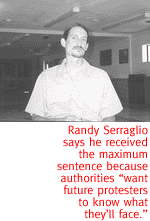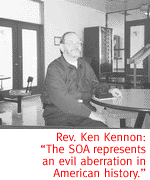
Tucsonans Serve Prison Time For Protesting Against The Pentagon's School Of The Americas.
By Richard Boren
TUCSONANS RANDY Serraglio and the Rev. Ken Kennon have
spent their summer behind bars. Their crime: peaceful participation
in a protest at the U.S. Army's School of the Americas (SOA) at
Ft. Benning, Georgia, nicknamed by critics "the School of
Assasins."
 Serraglio, Kennon and 600 other protesters, including a large
contingent of nuns, were arrested November 16, 1997, after they
marched onto Ft. Benning carrying black coffins. The coffins represented
the six Jesuit priests who, along with their housekeeper and daughter,
were murdered by SOA-trained Salvadoran soldiers on November 16,
1989. The protest was part of a campaign to close the SOA, which
has a long track record of training soldiers from Latin American
countries who end up abusing human rights. These days, Mexico
and Colombia are the SOA's biggest clients.
Serraglio, Kennon and 600 other protesters, including a large
contingent of nuns, were arrested November 16, 1997, after they
marched onto Ft. Benning carrying black coffins. The coffins represented
the six Jesuit priests who, along with their housekeeper and daughter,
were murdered by SOA-trained Salvadoran soldiers on November 16,
1989. The protest was part of a campaign to close the SOA, which
has a long track record of training soldiers from Latin American
countries who end up abusing human rights. These days, Mexico
and Colombia are the SOA's biggest clients.
The 34-year-old Serraglio, who is serving his time at a federal
facility near Safford, says he has adjusted to the "arbitrary
authority" of prison, where overcrowding is a way of life.
"You've got 725 prisoners warehoused in a place designed
to hold about 400," he says. "I share a 12-by-15-foot
cubicle with seven other people. Sardines come to mind."
Serraglio passes the days working in the prison kitchen for the
lucrative monthly pay of $5.25. He spends free time reading, writing
letters, and exercising. "This place would have exploded
a long time ago if it weren't for that big recreation yard out
there," he says.
Of the 601 people arrested last November, only 25--all repeat
offenders--were given prison time. The 25 had been among 60 people
arrested at Ft. Benning in 1996 and had been barred by the military
from entering the base for five years.
Christian Church of Disciples of Christ Rev. Ken Kennon was also
among the repeat offenders. The 63-year-old Kennon is currently
incarcerated in a prison work camp in Anthony, Texas. Kennon
was apparently seen as a lesser threat--there is no fence around
his prison. But this is no summer camp. Serving time at the "minimum
security" work camp is just as difficult as life at the highly
fortified Safford prison.
Kennon was initially assigned to serve his sentence at a prison
located on Ft. Bliss, an Army base in El Paso, Texas. Not one
to pass up a good opportunity to get his message out, Kennon and
other supporters held an anti-SOA protest outside Ft. Bliss the
same day he reported to prison.
 "Evidently the authorities at Ft. Bliss saw the media coverage
of the protest and didn't like it," Kennon said during a
recent prison interview. "Two days later I got called into
the Lieutenant's trailer and was told I was being moved due to
the reasons for my incarceration. Obviously Ft. Bliss wanted to
get me off their property. I was then put in shackles, a belly
chain, and handcuffs and driven to Anthony."
"Evidently the authorities at Ft. Bliss saw the media coverage
of the protest and didn't like it," Kennon said during a
recent prison interview. "Two days later I got called into
the Lieutenant's trailer and was told I was being moved due to
the reasons for my incarceration. Obviously Ft. Bliss wanted to
get me off their property. I was then put in shackles, a belly
chain, and handcuffs and driven to Anthony."
Like Serraglio, Kennon is coping relatively well with the challenges
of prison life. He receives lots of mail, including correspondence
from people he's never met. He shares a cubicle with one other
person, but even then, "your sleep is always interrupted
because they do counts all during the night, and it's pretty loud."
Both Kennon and Serraglio were active in Central American solidarity
efforts during the 1980s, when U.S.-financed wars raged in the
region. Kennon helped organize the Sanctuary Movement in Tucson,
which openly defied immigration laws by providing refuge for Central
Americans fleeing persecution in their countries. Serraglio has
also been an environmental activist. His last job was as campaign
coordinator for Save the Scenic Santa Ritas, an environmental
group which opposed a land swap between the U.S. Forest Service
and Asarco Mining Co. in southern Arizona.
"The SOA represents the inability of the U.S. government
to move beyond the Cold War," says Serraglio. "What's
the policy towards Mexico right now? Provide them with all the
helicopters and M-16s they need to maintain the status quo. We
have the documentation to show that counterinsurgency warfare
is the main thing being taught at the SOA."
 Serraglio and Kennon believe their sentence--the maximum allowable--was
meant to set an example.
Serraglio and Kennon believe their sentence--the maximum allowable--was
meant to set an example.
"The movement to close the SOA was mushrooming out of their
control," said Serraglio. "Five hundred people showed
up at the 1996 protest and then 2,000 last year. It's clearly
premeditated to go after us, not because of what we did, but because
of the political content of our speech. They want future protesters
to know what they'll face."
But support is growing in the U.S. Congress to close the school.
A vote in the House last September fell only seven votes short
of cutting off the SOA's funding (Tucson Rep. Ed Pastor voted
to close the school while Rep. Jim Kolbe voted against). Rep.
Matt Salmon, R-Phoenix reversed his position and has even agreed
to be a co-sponsor of the bill (HR 611) to shut down the SOA.
For Kennon, that shutdown can't come soon enough.
"The SOA represents an evil aberration in American history,"
he says. "The school is the embodiment of U.S. foreign policy
to keep the economic elite in power in order to better protect
U.S. investments. I've personally known many victims of the school."

|





